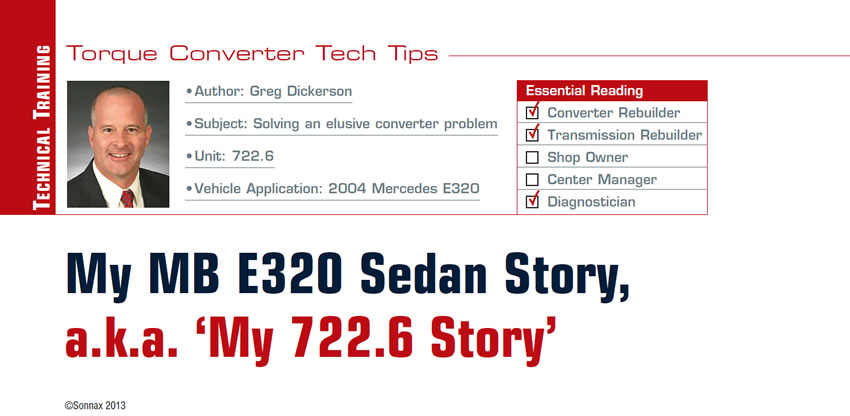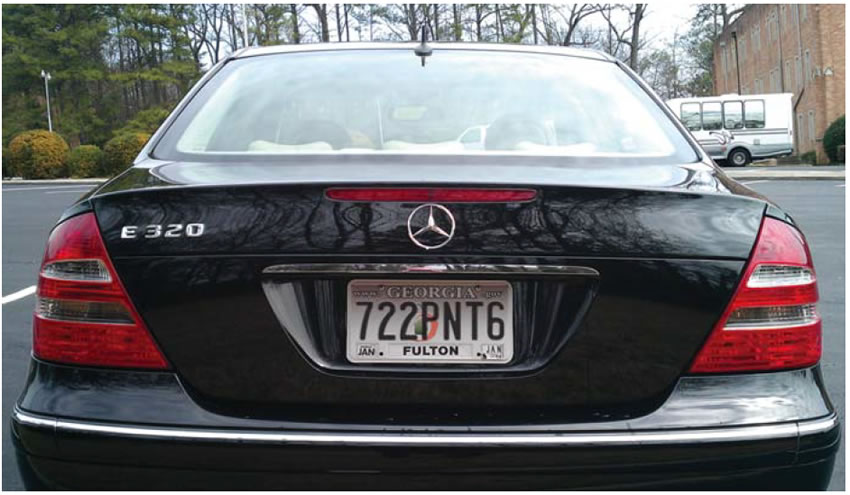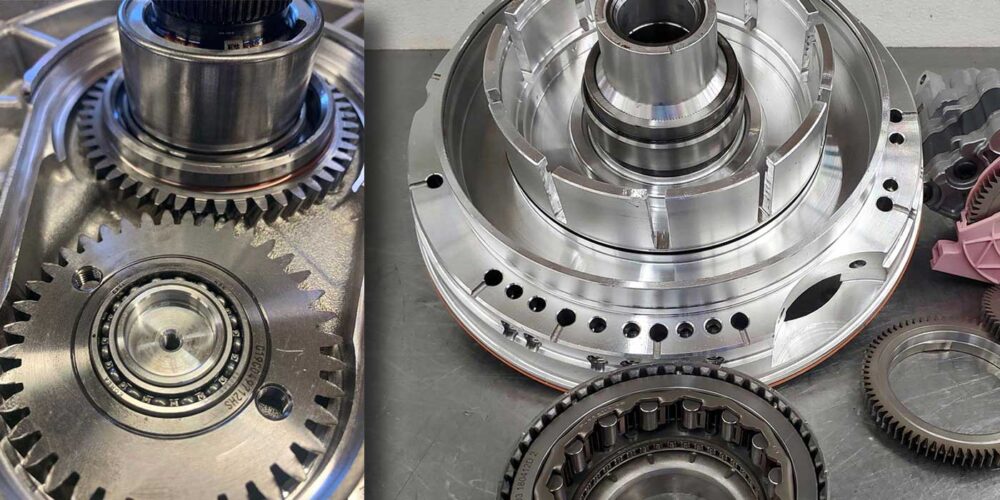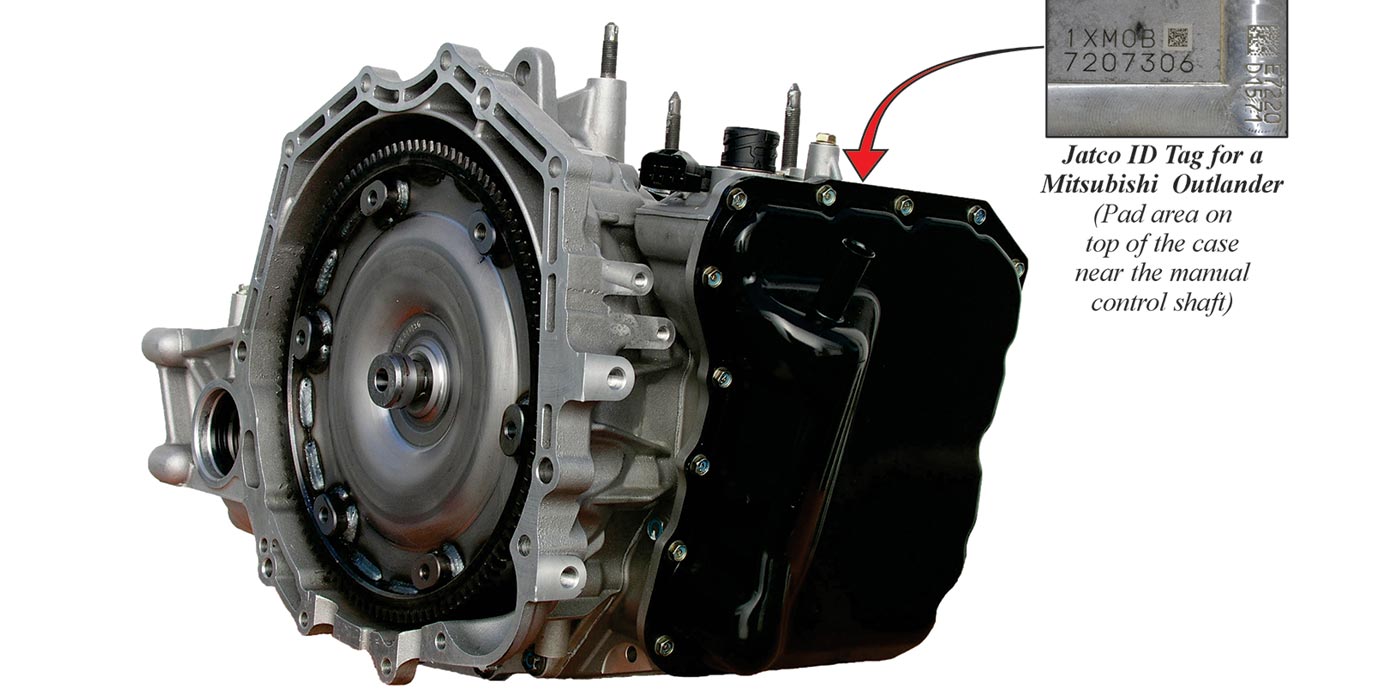
Torque Converter Tech Tips
- Subject: Solving an elusive converter problem
- Unit: 722.6
- Vehicle Application: 2004 Mercedes E320
- Essential Reading: Converter Rebuilder, Transmission Rebuilder, Diagnostician
- Author: Greg Dickerson
Editor’s Note: This month we make a temporary departure from the traditional Torque Converter Tech Tip article. Instead, we offer a different perspective: a torque-converter story as experienced and told by the vehicle owner. In our business we wrestle with the technical side of completing repairs and we all try to remain focused on the fact that some individual, outside our industry, owns and drives that vehicle. This gentleman not only had the motivation and determination to resolve a multi-year ongoing problem but also was willing to make a 15-hour drive to take the vehicle to a shop that he believed could fix that problem. We let him tell it in his own words.
Introduction
My introduction is to tell you that this story is about my torque-converter problem. The conclusion of the story is to tell you that the problem was resolved. However, the story and the journey lasted several years.
After driving mostly Japanese cars during my adult life, I decided at the end of 2006 to try something different. The Japanese cars were great for me, especially with my experience being virtually free of any repairs. Just change the oil and keep driving; reliability – the hot button for me. As a single-car owner and someone in a line of work where my car is necessary and critical, I need to count on my car every day. However, after a couple of decades of reliable but “plain vanilla” driving experiences with the fine sedans from the land of the rising sun, I decided to test drive a few vehicles and planned to purchase a different vehicle in early 2007.
The purchase of my 2004 MB E320 in January 2007
I was not sure exactly what I wanted when I began my search, but I did feel a natural gravitation toward the German makes. I had already owned a couple of two-wheeled vehicles from the Germans and was pleased with the “Fahrvergnügen.” So, keeping an open mind, I started the process here in Atlanta with a local dealer of used luxury makes and models. I was 99% sure that whatever I decided to purchase would be from this dealer, a trustworthy place known for offering late-model, low-mileage automobiles coming off “first driver” leases. Plus, I had purchased from this dealer earlier in life, so my plan seemed logical.
I visited the dealer and started driving. I tested a few flagship sedans from Europe and Japan and liked the S-class Mercedes the best. As a first-time Mercedes buyer, though, I figured I should try the less- expensive E-class as my entry point. Since I figured the E-class was the backbone of the MB line, it should be the most-reliable and proven vehicle. I made my purchase in January 2007: a 2004 MB E320 sedan with 26,487 miles. It had almost one year remaining on the factory warranty or 60,000 miles, whichever came first by the end of 2007. So, a new driving experience for me and the peace of mind of the warranty protection. I also planned to purchase the extended warranty before the end of 2007 to protect me in the future, so I was all set.
The early years of my ownership (January 2007-May 2011)
It is beyond the scope of this article to list and discuss all the items on this car that were serviced or repaired during this period. Let me just say that both the factory warranty and extended warranty were invaluable and well used. What I do want to discuss is the one thing that was bothersome ever since I purchased the car.
As I became familiar with the car during the first several weeks of ownership, I noticed odd sensations in the way the car shifted. Now, years later, I know some of these sensations are commonly described as shudder, judder, rumble strips, loping, bucking, jerking etc., but earlier in my ownership I would describe these sensations as “something is not right with my car,” “quirks,” “intermittent strange shifting sensations” etc. I am sure the technical reader of this article can visualize me explaining this to the service writer at the MB dealership.
The outcome of all those visits was a bunch of Q&A sessions between the service writers and me. Do I drive with one foot or two? Am I resting my left foot on the brake all the time? Am I changing my driving habits periodically? Is more than one person in the household driving the car? And on and on. The “remedy” from the dealer’s service department: “We reset the adaptive shifting software (again), so everything will be OK now.” Imagine a few years of this. I am well known by my peers for having great patience!

June 2011: odometer 81,000 miles
My car’s extended warranty was scheduled to expire in December 2011. I was covered for 100,000 miles, but December would arrive before the mileage limit (the odometer showed 81,000). Through a trustworthy source I found an independent mechanic who specialized in MB. I basically gave him my car for a week and told him that the project at hand was to help me determine whether I should sell the car while it was still under warranty or it was a “keeper” and a good risk for me to hang onto after the extended warranty expired. The result: We determined that the car was in great condition and I should keep it but that some preventive maintenance would be performed for good measure. The main focus was to make a “preemptive strike” and hopefully prevent transmission-related problems from arising in the future. Among several other things, I elected to replace the radiator, replace hoses and perform a transmission service.
December 2011 came and went, and so did my extended warranty, but I felt reasonably confident about my decision to keep the car based on the process I went through and the work that had been performed.
August 2012: odometer 94,000 miles
I finished filling up at the gas pump and went to drive away, but the car would not move. Oh yeah, release the parking brake. It was released. OK, now the car was rolling – kind of – but now it’s stopped. This went on for a few hundred yards. One flatbed truck later, my car was back in the same mechanic’s shop where it had been “preemptively” serviced. Three hours later, he called me after his transmission rebuilder visited the shop and checked out my car.
“Transmission is shot,” I was told. I picked up my car a few days later after a remanufactured transmission and torque converter were installed (both units to factory specifications, I was told). It was a tough pill to swallow, but I tried to be positive. I said to myself, “Now my car is really ready for the long, long haul.” Guess what I noticed after driving for a few minutes, though. The shifting quirks, the strange shifting sensations, the “something is not right with my car” from back in 2007 when I first bought it! The sensations that I described using industry lingo earlier in this article!
You can imagine the phone calls and conversations with my mechanic! He had sourced the remanufactured transmission and torque converter from a local rebuilder, and I requested that the mechanic put me in touch with him so that I could begin some Q&A with this individual. Unfortunately, I was told that the rebuilder was not open to the public and would not field any questions from the consumer/car owner. I knew at that instant that my own personal research project had been born. My gut feeling was that there was something not right about this car and that it had started long before I ever was the owner.
The research project: Step 1
Thank goodness for the Internet. I spent hours and hours over a period of weeks learning about and studying transmissions, valve bodies and torque converters. My initial searches were along these lines: “What is a torque converter?” “How does a transmission work?” “What is wrong with my MB transmission?” etc. This led to studying cross-sectional diagrams of all these components, reading countless blogs about people having similar issues and problems. Eventually I began reading technical articles and journals from the auto industry.
After several weeks of this type of research, I formed my own preliminary conclusion. Of course, I would ultimately need to have it confirmed by a professional, but my instincts told me this: There was nothing wrong with my transmission. It had been remanufactured, and not too much could go wrong with planetary gear sets etc. Since I also had ruled out the valve body based on the particular and most-troublesome shifting sensations with my car, I thought that the problem must be the torque converter. But that ALSO had just been remanufactured! “Who cares?” I said to myself. “The torque converter is the problem. I know it is. It must be.”
The research project: Step 2
If Step 2 in the project were given another title, it would be “Where are the Springs?” Not to go too deep here, but let’s just say this step in the process involved calling lots of people in the auto industry and asking lots of questions about torque converters and torque-converter modification – not modifications in the sense of souping up a race car, but in the sense of making a daily driver behave like a proper daily driver. So I made a lot of calls, multiple calls, sometimes to the same people over and over again. All these people exercised great patience with me and were very helpful.
By the time I completed “Step 2” of my investigation, I had convinced myself that the torque converter was indeed the problem with my car. No individual among those mentioned ever made a statement that the converter was the problem, and they should not have because at this point none of them had met me or driven my car. I was ready for the next step, though, hopefully the final step, the solution: the modification of my torque converter, which would include the installation of TCC-piston return springs. (The factory converter does not contain springs as part of its design).

Problem solved, January 2013: odometer 98,593 miles
I made a little “vacation” trip to a small town in Delaware in January of this year. Delaware – January – not the typical winter destination for a Southerner. But guess what. My car was fixed. F-I-X-E-D.
I dropped my car for a few days at a local transmission shop. I didn’t just walk in on them; they knew I was coming. They were already kind of familiar with me from some of the phone calls, and knew I was paying them a visit because I wanted to conduct an experiment. As a progressive, solution-driven type of shop, they were open minded and willing to help. Understanding that the warranty on my remanufactured torque converter would be voided, I gave them the OK to cut open the converter and rebuild it again. Yes, rebuild it again, but this time modifying the insides with the installation of aftermarket TCC-piston return springs. A nearby hotel was my home while they worked on the car.
The shop called a few days later after the “surgery” was complete and asked me to test drive the car. As I slowly rolled away from the shop, I knew the problem was solved before I even exited the parking lot. The seven-mile test loop was a flawless shifting experience. The converter came on and off as one would expect in a smooth-shifting car. The car performed exceptionally all the way back to Atlanta and continued to do so on the rolling inclines and declines of Atlanta’s streets. All the unwelcome sensations associated with my car disappeared, regardless of temperature, cold or hot. Problem solved.
Closing
In closing, I learned a lot. For me, I tried to put a positive spin on the problem. My experiment was a mental challenge and reminded me of my days in engineering college some 25 years ago. That said, I never want to go through this again with any car. Although I am in the real-estate business, I am fortunate to have a working understanding of things mechanical because of my schooling and having been raised by a mechanically inclined father. Whoever would have thought so many years later that I would be exercising my brain around a car problem like this!

Now, the final question: To keep the car or not? If no, then the next driver will certainly have a great-shifting sedan with a wonderful personality. If yes, then maybe I will apply for a new vanity license plate: 722PNT6.

Greg Dickerson is a native Georgian and Georgia Tech graduate. After an engineering career in California’s aerospace industry, he returned home to Georgia, establishing himself as a successful industrial real-estate broker in the Atlanta area.
©Sonnax2013













